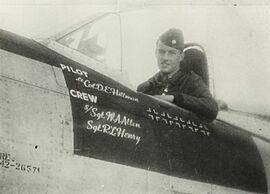Donald E. Hillman facts for kids
Quick facts for kids
Donald E. Hillman
|
|
|---|---|

Lt. Col. Hillman in his P-47
|
|
| Born | August 24, 1918 Seattle, Washington, U.S. |
| Died | March 16, 2012 (aged 93) Seattle, Washington, U.S. |
| Allegiance | United States |
| Service/ |
United States Army Air Corps United States Army Air Forces United States Air Force |
| Years of service | 1940–1962 |
| Rank | |
| Unit | 365th Fighter Group 1st Fighter Wing 306th Bombardment Wing |
| Commands held | 386th Fighter Squadron 388th Fighter Squadron 94th Fighter Squadron 6th Air Mobility Wing |
| Battles/wars | World War II |
| Awards | Silver Star (2) Legion of Merit Distinguished Flying Cross (4) Purple Heart (2) Air Medal (34) Army Commendation Medal (2) Croix de guerre (France) |
| Other work | Air Force liaison for Boeing |
Donald Edison Hillman (born August 24, 1918 – died March 16, 2012) was an American pilot and hero. He was a "flying ace" during World War II, which means he shot down five enemy airplanes. He was also a prisoner of war during the war. Later, in 1952, he became the first American pilot to fly a secret mission deep into Soviet territory to gather information.
Contents
Early Life
Donald Hillman was born in Seattle, Washington, on August 24, 1918. He went to Broadway High School. After high school, he studied at the University of Washington for a short time. He then transferred to the Virginia Military Institute and later to Stanford University. He earned a business degree from Stanford in 1939.
A Brave Pilot in World War II
Donald Hillman joined the military in October 1940. He trained to become a pilot with the United States Army Air Corps. In 1943, he was sent to Europe to fight in World War II. He became the commander of the 386th Fighter Squadron.
Flying P-47 Thunderbolts
Hillman flew powerful planes called P-47 Thunderbolts. His job was to protect other planes during missions. He flew with the Eighth Air Force and later the Ninth Air Force. He was a very skilled pilot and became a "flying ace." This special title is given to pilots who shoot down five or more enemy aircraft.
Captured and Escaped!
Later in 1944, Donald Hillman's plane was shot down. He was captured and became a prisoner of war (POW). He was held in a camp called Stalag Luft III. He tried to escape from this camp but was not successful.
After his first attempt, he was moved to another prison camp. This time, he managed to escape! A German officer, who no longer believed in the war, helped him. They escaped together and later became good friends after the war ended.
Secret Missions in the Cold War
After World War II, Donald Hillman continued his important work in the Air Force. On October 15, 1952, he flew a special plane called a Boeing B-47B Stratojet. At this time, he was a Colonel and a leader in the 306th Bombardment Wing.
His mission was very secret and important. He flew from Eielson Air Force Base in Alaska, over the Arctic Ocean. Then, he turned east and flew over Siberia, which is part of the Soviet Union. He returned to Alaska after flying over Provideniya. This was the first time the United States had flown a deep "reconnaissance" mission over the Soviet Union. Reconnaissance means gathering information, often by flying over an area to see what's there.
Later Life
Donald Hillman retired from the Air Force in 1962. After his military career, he worked for Boeing in Seattle. He helped connect the Air Force with the company. Donald Hillman passed away on March 16, 2012, at the age of 93. He was a true American hero who served his country bravely.

